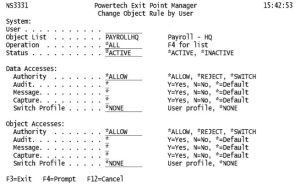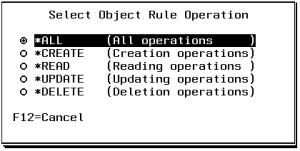How to Get There
From the Security Configuration Menu, select option 4 to display the Work with Object Lists panel. Then, enter option 9 next to one of the Object Lists. On the Object Rules using Object List panel, enter option 2 next to a user.
What it Does
The Change Object Rule by User panel allows you to modify an Object Rule's attributes.
Options
User
User represents the identity of the person initiating a transaction as a user profile. The special value *PUBLIC, when used on a rule, means that the rule applies to any User lacking a specific rule. when used as a subset or selection parameter, *PUBLIC means to select all such rules for display or printing.
Object List
The Object List name is a short name you assign to a list of objects to help you identify the list. This name is required to be a valid OS name.
Operation
Operation represents the type of action being performed upon an object or upon the data in an object.
The valid values are:
Status
Status indicates that an Object Rule is active (being enforced) or inactive (not being enforced).
Data Accesses
Use the Data Accesses fields to specify location rights to the data in the objects in the Object List.
Authority
Authority represents the action to be taken when a rule is found that matches the data present on a transaction. This Authority value pertains to Data Accesses.
The valid values are:
Audit
The Audit flag controls the logging of transactions to the Log Journal set up on the work with Powertech Exit Point Manager for IBM i System Values panel. This Audit flag pertains to Data Accesses.
The valid values are:
Message
The Message flag controls the sending of messages to the Log Message Queue set up on the Work with Powertech Exit Point Manager for IBM i System Values panel. This Message flag pertains to Data Accesses.
The valid values are:
Capture
The Capture flag controls whether transactions are remembered in Powertech Exit Point Manager for IBM i for later memorization. Once captured, transactions can become Memorized Transactions, which can act as rules. This Capture flag pertains to Data Accesses.
The valid values are:
Switch Profile
The Switch profile holds the name of a user profile whose authority is used to process the transaction instead of the authority of the User initiating the transaction. The transaction is executed as, and uses the authority of, this Switch profile. The job that processes the transaction continues to run under this switch profile until Exit Point Manager processes another transaction request for that job.
Switch profile is allowed only when Authority contains *SWITCH or *MEMSWITCH, if *MEMSWITCH is allowed. Otherwise, it must contain *NONE. This Switch Profile pertains to Data Accesses.
Object Accesses
Use the Object Accesses fields to specify location rights to the objects in the Object List.
Authority
Authority represents the action to be taken when a rule is found that matches the data present on a transaction. This Authority value pertains to Object Accesses.
The valid values are:
Audit
The Audit flag controls the logging of transactions to the Log Journal set up on the work with Powertech Exit Point Manager for IBM i System Values panel. This Audit flag pertains to Object Accesses.
The valid values are:
Message
The Message flag controls the sending of messages to the Log Message Queue set up on the work with Powertech Exit Point Manager for IBM i System Values panel. This Message flag pertains to Object Accesses.
The valid values are:
Capture
The Capture flag controls whether transactions are remembered in Powertech Exit Point Manager for IBM i for later memorization. Once captured, transactions can become Memorized Transactions, which can act as rules. This Capture flag pertains to Object Accesses.
The valid values are:
Switch Profile
The Switch profile holds the name of a user profile whose authority is used to process the transaction instead of the authority of the User initiating the transaction. The transaction is executed as, and uses the authority of, this Switch profile. The job that processes the transaction continues to run under this switch profile until Exit Point Manager processes another transaction request for that job.
Switch profile is allowed only when Authority contains *SWITCH or *MEMSWITCH, if *MEMSWITCH is allowed. Otherwise, it must contain *NONE. This Switch Profile pertains to Object Accesses.
See Object Rules.
Command Keys
F3 (Exit): Exit the panel without processing any pending changes.
F4 (Prompt): Displays a list of possible values.
F12 (Cancel): Exit the panel without processing any pending changes.

